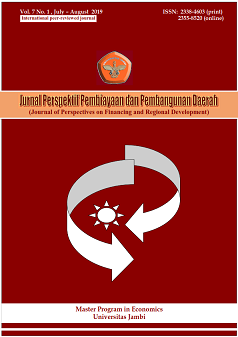Human capital of school-age population in West Sumatera: measurement and determinant
DOI:
https://doi.org/10.22437/ppd.v7i1.6977Abstract
Information on human capital, especially for school- age population is still limited. Most of Indicators of human capital only consider the dimensions of education, while human capital is formed by various dimensions not only education. Recent human capital measurement is displayed in macro level so that difficult to analys in micro level. Based on recent condition of human capital information, this study aims to measure the human capital of the school-age population of 7-18 years old using the fuzzy set approach by considering several dimensions of human capital investment and analysis the determinant. The data source is from West Sumatera Socio-Economic Survey that held by National Bureau of Statistic in March 2017. Measurement human capital of 9,950 samples of school age population shows that urban areas have higher human capital than the rural areas. Internal factors, household and spouse characteristics such as income, parent education and occupation have impact in their children human capital. External factors such as subsidies and rural-urban development inequality also have impact and tend to be larger than internal factor. The strategy of increasing human capital under conditions of limited resources can be achieved by increasing the index of indicators which have greatest weight and also reducing development inequality between urban and rural areas. The other policy is to realize growth economic that have positive impact to entire society. In terms of methodology, this approach can be adapted to regional conditions, the development of theory and related research. Adjustments can be made at the stage of selecting investment indicators, data types and weight of indicator
Downloads
References
Akresh, R., Bagby, E., de Walque, D., & Kazianga, H. (2012). Child Ability and Household Human Capital Investment Decisions in Burkina Faso. Economic Development and Cultural Change, 61(1), 157–186. https://doi.org/10.1086/666953
Alkire, S., & Foster, J. (2011). Counting and multidimensional poverty measurement. Journal of Public Economics, 95(7–8), 476–487. https://doi.org/10.1016/j.jpubeco.2010.11.006
Allo, A. G., Sukartini, N. M., & Saptutyningsih, E. (2018). Smoking Behavior and Human Capital Investment : Evidence from Indonesian Household. Jurnal Ilmu Ekonomi, 7(4), 233–246.
BPS. (2012). Analisis Statistik Sosial Bonus Demografi dan Pertumbuhan Ekonomi. Jakarta: BPS
Beach, B., Ferrie, J., Saavedra, M., & Troesken, W. (2014). Typhoid Fever, Water Quality, and Human Capital Formation. NBER Working Paper Series.
Becker, G. S. (1962). Investmen In Human Capital : A Theoretical Analysis. Journal of Political Economy, 9–49.
Blandin, A., & Herrington, C. (2018). Family Structure, Human Capital Investment, and Aggregate College Attainment. Mimeo, Virginia Commonwealth University.
Brata, A. G. (2002). Pembangunan Manusia dan Kinerja Ekonomi Regional di Indonesia. Jurnal Ekonomi Pembangunan, 7(2), 113–122.
Bridge, B. A., Adhikari, D., & Fontenla, M. (2016). Electricity , income , and quality of life. The Social Science Journal, 53(1),33 - 39
Bulman, G., & Fairlie, R.W. (2016). Technology and Education : Computers, Software, and The Internet. NBER Working Paper Series. Retrieved from http://www.nber.org/papers/w22237
Cerioli, A., & Zani, S. (1990). A Fuzzy Approach to The Measurement of Poverty. Conference paper, Income and Wealth Distribution, Inequality and Poverty, 272 - 284
Christian, M. S. (2017). Net Investment and Stocks of Human Capital in the United States, 1975-2013. International Productivity Monitor, (33), 128–149.
Cohodes, S., Grossman, D., Kleiner, S., & Lovenheim, M. F. (2014). The Effect of Child Health Insurance Access on Schooling : Evidence From Public Insurance Expansions. NBER Working Paper Series.
Costa, M. (2002). A Multidimensional Approach To The Measurement Of Poverty. IRISS Working Paper Series.
Dang, H.A.H., & Rogers, F.H. (2016). The decision to invest in child quality over quantity: Household size and household investment in education in vietnam. World Bank Economic Review, 30(1), 104–142. https://doi.org/10.1093/wber/lhv048
Leu, C.H., Chen, K.M., & Chen, H.H. (2016). A multidimensional approach to child poverty in Taiwan. Children and Youth Services Review, 66, 35–44. https://doi.org/10.1016/j.childyouth.2016.04.018
Liu, Z. (2003). The Economic Impact and Determinants of Investment in Human and Political Capital in China. Economic Development and Cultural Change, 51(4), 823–849. Retrieved from http://www.journals.uchicago.edu/doi/10.1086/375570
Mankiw, G.N., Romer, D., & Weil, D.N. (1992). A Contribution to the Empirics of Economic Growth. The Quarterly Journal of Economics, 107(2), 407 - 437
Qin, X., Wang, T., & Zhuang, C.C. (2016). Intergenerational transfer of human capital and its impact on income mobility: Evidence from China. China Economic Review, 38, 306–321. https://doi.org/10.1016/j.chieco.2014.10.005
Setiawan, M.B., & Hakim, A. (2013). Indeks Pembangunan Manusia Indonesia. Jurnal Economia, 9, 18–26.
Taifur, W.D. (2005). Kemiskinan Mengikut Sektor Pekerjaan dan Daerah di Provinsi Sumatera Barat. Universiti Malaya.
Taifur, W.D. (2012). Kebijakan Pembangunan yang Berpihak Kepada Penduduk Miskin. Jurnal Riset Akuntansi Dan Bisnis, 12(2), 233–252.
Thakurata, I., & D’souza, E. (2017). Child labour and human capital in developing countries - A multi-period stochastic model. Economic Modelling, 68(C), 1–15. https://doi.org/10.1016/j.econmod.2017.09.006
Thamma-Apiroam, R. (2015). Approaches for Human Capital Measurement with an Empirical Application for Growth Policy. Asian Social Science, 11(26), 309–322. https://doi.org/10.5539/ass.v11n26p309
UNDP. (2018). Technical notes: Calculating the human development indices-graphical presentation.Human Development Report 2016. UNDP
Wang, Y. (2018). Educational and nutritional consequences of education subsidy in rural China. China Economic Review, 51, 167-180. https://doi.org/10.1016/j.chieco. 2018.03.004
Yang, D. (2008). International migration, remittances and household investment: Evidence from Philippine migrants’ exchange rate shocks. Economic Journal, 118(528), 591–630. https://doi.org/10.1111/j.1468-0297.2008.02134.x
Zadeh, L. A. (1965). Fuzzy Sets. Information and Control, 353, 338–353.
Downloads
Published
How to Cite
Issue
Section
License
Copyright (c) 2019 Firlan Firlan, Werry Darta Taifur, Indrawari Indrawari

This work is licensed under a Creative Commons Attribution 4.0 International License.

















